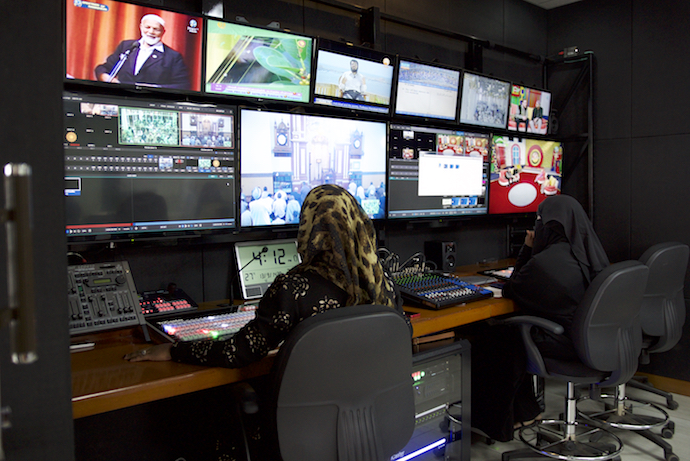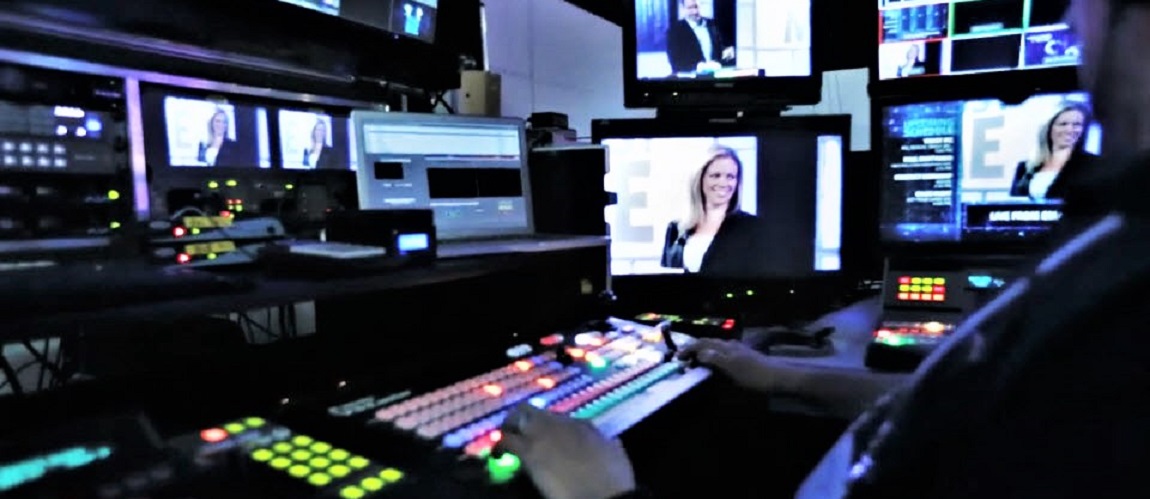Live Switching Hundreds of Miles Away Through the Cloud With NDI®
In a League of Their Own
Nearly a half-century ago, in 1968, a new sanctioning body for slow-pitch softball was formed: the United States Specialty Sports Association, now known simply as USSSA.
In television production terms, 1968 seems a lifetime ago. Early communications satellites and microwave relays were just making it possible to tap into remote live feeds.
But just a few years later, TV stations transitioned to tape-based production, equipped with electronic newsgathering (ENG) and downlink capabilities. That meant local stations could receive, for the first time, live footage created by their own production crews and transmitted by satellite trucks covering sports anywhere.
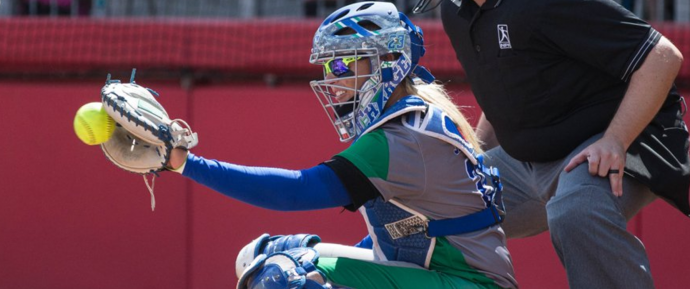
Today, organized amateur sports look nothing like they did in 1968. But the process for delivering live sports? That’s nearly the same.
And that’s what led Bernie Guenther, USSSA’s Director of Advanced Media, to adopt a new mission statement for the association’s live sports productions: “We want to live in the future. Not the past.”
The future is taking a very different path for USSSA, and so is the video the group produces – a new path blazed by NDI® (Network Device Interface), NewTek’s software interface for frame-accurate live video over IP.
Leaving the production truck home, and the costs and logistics that go along with it, USSSA is sending its camera feeds from ballparks to the home control room for live switching – hundreds of miles away. Through the cloud.
On-Location Frustration
Since those early days, USSSA has grown to 4.5 million participants playing sports in 40,000 events across the country every year. It governs more than 100,000 teams in 14 nationally sanctioned sports and holds international events as well.
And – unthinkable 50 years ago – it produces live game coverage of amateur sports at all ages and levels as well as for its own professional softball team, the National Pro Fastpitch league’s USSSA Pride.
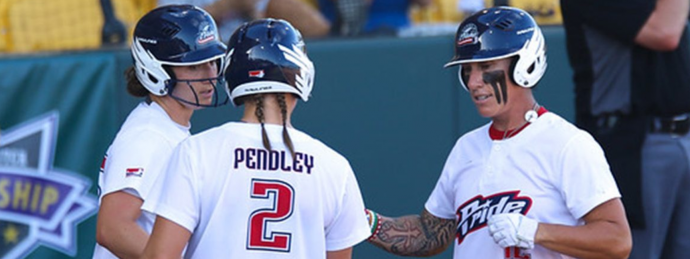
“We started doing it in 2009, using a TriCaster Broadcast,” says Guenther, referring to NewTek’s first all-in-one production switcher to support broadcast-standard SDI connections. “What we’ve tried to do is create this network-quality platform for the thousands of viewers that are interested in a particular niche sport.”
Network quality is important for the channels that carry their programs. They’ve had network television games broadcast on CBS Sports; and in just the past few years, they’ve produced thousands of games on their own live streaming platform as well as more than 200 games on MLB.com, ESPN3 and regional television.
Not always a straightforward task: “No matter the quality of the truck you bring on the road,” says Guenther, “you always spend an enormous amount of time setting things up. The majority of the 6 hours before the game is getting the truck set up, preparing to do your show.”
Complicating the location issue was the association’s constant frustration of coordinating playing fields with counties and municipalities around the country.
For years, the group had to scramble to find locations every season for dozens of recreational tournaments and major national championships. In a 2011 interview, USSSA’s CEO Don DeDonatis mentioned his biggest challenge was finding suitable facilities that met the association’s standards.
“It’s always been a vision of our CEO to have our own place where our events weren’t at the mercy of other people,” says Assistant Director of Advanced Media Paul O’Leary.
Today, they’re making it happen. They’ve relocated to the USSSA Space Coast Stadium, former spring training home of the Washington Nationals major league baseball team in Viera, Florida. Construction has started on a major $32 million expansion project to transform it to a brand new 15-field, all-turf complex.
 Aerial view of part of the USSSA Space Coast Complex, a new $32 million, 15-field all turf facility in Viera,
Aerial view of part of the USSSA Space Coast Complex, a new $32 million, 15-field all turf facility in Viera,
Instead of juggling national events scattered among different ball fields each year, they can now bring athletes from around the country to them. With highly evolved visual technology including multiple video boards, swing analysis and 3D ball tracking radar, USSSA Space Coast Complex will give kids and amateur athletes the experience of a lifetime.
In 2018, they expect to host 50 events with a half-million people passing through the gates. But already, with their NewTek IP Series system, they can produce network-quality live games around the country without leaving their newly built, connected control room.
Space-Age Location
“On June 11th, from a National Professional Fastpitch League game 311 miles away,” says O’Leary, “we became the first to do a live multi-camera, publicly streamed production using IP Series and the beta Sienna Cloud for NewTek NDI.”
The inaugural, fully NDI-based production was a match featuring the USSSA-owned women’s fastpitch team the Pride vs the Chicago Bandits. It took place on the campus of Florida State University in Tallahassee.
Although that site is considered the Pride’s home-field, it’s more than 300 miles from the association’s new headquarters, says Guenther, who is no stranger to remote live productions.
“In my last couple of years of working in network television, we probably did 70 games from the big trucks,” he says, including coverage at the Sochi Winter Olympics in 2014.
But notably missing from this game? The truck.
Instead, says O’Leary, “In Tallahassee, I had 4 camera guys on site with me, that’s it. Our reporter was there so she did live sideline interviews, live hits, and post-game interviews. We sent back the four camera feeds with video and embedded audio on different channels. Back to our control room, the game was cut, audio mixed, replay and graphics overlaid on the IP Series – all live.”
Remote Production (Like a Local)
Making the all-IP production possible were four key NDI-enabled components:
- At the field: NewTek MediaDS for SDI camera output, conversion, and network connectivity to send the camera signals out over IP;
- In the control room: NewTek IP Series modular production system for switching all the IP sources, adding in graphics and mixing the complete live production;
- Also in the control room, a NewTek Studio Input Module routing the cameras over SDI to a NewTek 3Play system for slow motion and instant replays;
- In between a beta version of Sienna Cloud™ for NewTek NDI®, a WAN relay service from third-party developer Sienna, allowing NDI connectivity between the two locations without a dedicated pipe.Guenther says, “We designed our control room with the vision that our equipment would allow us to do remote broadcasting. That was first and foremost.”
With Sienna’s cloud-enabled NDI delivery, the TD switching the IP Series in the control room could select the game cameras and audio from the same menu as local networked and attached devices. This makes a remote production as easy to set up as if all sources were in the same room, fitting Guenther’s and O’Leary’s forward-looking concept for their new control room.
“Having our control room based around the IP Series allows us to be way more cost effective than we ever could before because you’re not moving the truck, needing power, and taking all that time to coordinate,” says Guenther.
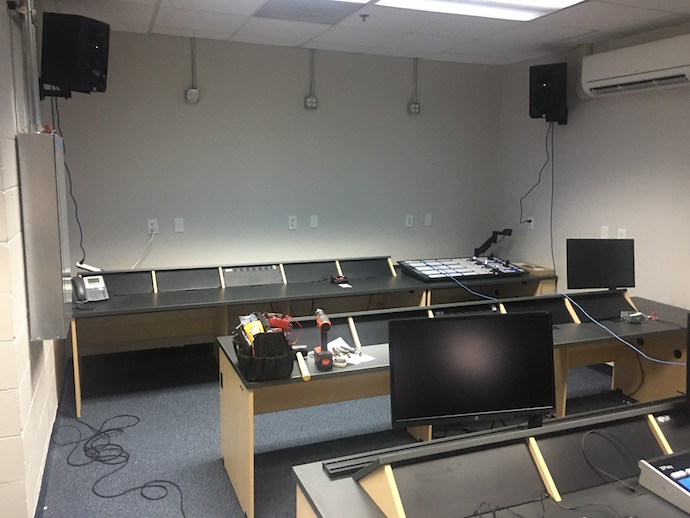

Network Quality Platform
Remote capability was the first thing Guenther and O’Leary looked for, but not the only thing. They needed to produce programs their audience would love to watch.
“We adhere to making shows look like the highest quality they possibly can. You want the viewership to be able to sit back and enjoy the game just as much as they would one of the big networks,” says Guenther.
“We don’t have a budget to do the things we could do on network television, but we try to get as close to that as possible, as cost effectively as we can,” he says. In other words, without the expense of purchasing, operating and maintaining a production truck.
But the quality of IP delivery was also important because – according to O’Leary – the Space Coast Stadium is ultimately going to be all-IP, and programs produced here would need that network-level look.
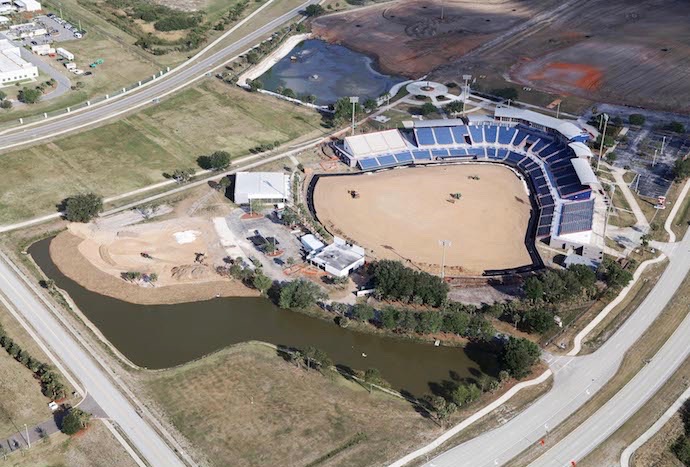
“We’re going to have 15 fields here in total, across the complex,” he says. “We’ve already planned our network backbone so we can have cameras in every field. That way we can have every single stream coming into the NDI architecture.”
In fact, says O’Leary, since any NDI-enabled device on the network is visible to all the others, “All we have to do is connect a camera anywhere. Once it’s on the network, everything just comes back to our control room. We can, at any time, push a button and pull up any field, any camera.”
Which they’ve now tried, having produced three games with the IP Series at the stadium, prior to their successful long-distance experiment (and only three days after the completion of the control room).
Guenther says, “It is pretty amazing how you can take a Studio Input Module and put it on part of your network, and next thing you know four cameras blast back at your IP Series from other parts of your network – and they still have that same picture quality without having to run cable all over the place.”
He says the results of producing their initial programs using NDI drove it home. “The quality looks just as good as if it came back baseband. You can’t distinguish between the two platforms.”
Equipping the Future
Ultimately, the direction of the USSSA – and of the video productions they deliver – is focused on the future. And that made their equipment decision easier.
“The biggest reason we went with the IP Series, in all honesty, is the flexibility of the formats we’ll potentially use in the future,” says Guenther. After all, the group has already been through fifty years of organized sports, technology, and viewing trends and habits. Living in the past is not an option.
“We’re only a few games in and I just can’t wait to see, once we’ve truly unlocked all the tools it has, how much we can really do with it,” says Guenther. “I can’t even imagine what the future holds.”
“I wanted to make sure that we had a platform that could grow,” he says. “Since the IP Series is already 4k available and software upgradeable, I feel like it will set us up to grow and expand as technology continues to change.”
Since that initial remote production in Tallahassee, they’ve used their NDI systems to cover more miles – an away series from Miami at 200 miles, and another 1200 miles away in Kansas City.
Future formats and expandable platforms aside, with virtually any networked source available to use in a video program, the possibilities for IP Series live production keep Guenther and O’Leary continually pushing the boundaries of their shows.
More articles by Ellen Camloh:
- BET Betting Big on IP Workflows
- No SDI? No Problem! Growing Esports Productions Over IP
- Sports Workflows With IP Integration: Webstream Sports Tupelo-Raycom
Learn more about:
Where to Buy
NewTek Products

NewTek has a network of resellers located around the world. All of them are experts in our product and in the video production and streaming industry.
Use this tool to find a NewTek reseller near you.
Speak with a Solutions Expert
Get expert advice on a live production workflow around NewTek systems and NDI or let us connect you with one of our local partners, our Solutions Experts are here to help.
